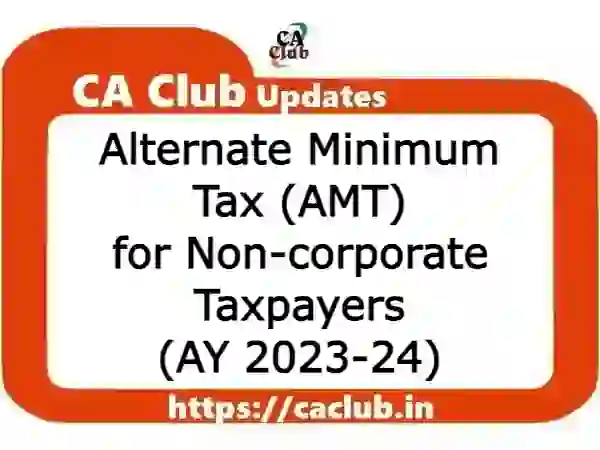Introduction
Taxes fundamentally sustain the economic health of a nation. In India, taxpayers are classified generally into two broad categories, i.e. corporate and non-corporate taxpayers. This post explain the concept of Alternate Minimum Tax (AMT), a special taxation perspective focused on non-corporate taxpayers, in respect of AY 2023-24.
What is Alternate Minimum Tax (AMT)?
AMT in India is a tax imposed on individuals and businesses that benefit from deductions and credits to reduce their tax liability. Instituted to ensure these taxpayers pay their fair share, AMT exists as a tax assessment tool, setting a minimum threshold of tax that every taxpayer has to pay, regardless of the deductions and exemptions they can avail themselves of. The Income Tax Act makes AMT provisions applicable to non-corporate taxpayers, under section 115JC.
The AMT is applicable to non-corporate taxpayers whose regular tax on total income falls below specific thresholds, i.e. 18.5% for most taxpayers, 9% for IFSC units, and 15% for cooperative societies. The AMT is calculated based on the “Adjusted Total Income,” which factors in various deductions claimed by the taxpayer.
Who are liable to pay AMT?
The concerning fact about AMT is that it applies to a broad spectrum of non-corporate taxpayers (i.e. other than domestic/foreign companies) including:
i) Any individual;
ii) Hindu Undivided Family (HUF);
iii) Association of Persons (AOP);
iv) Body of Individuals (BOI);
v) Artificial Judicial Person;
vi) Partnership firms; and
vii) Limited Liability Partnerships (LLPs).
AMT essentially impacts those non-corporate entities who claim deductions under Chapter VI-A of the Income Tax Act (i.e. under sections 80H to 80RRB except 80P), section 10AA or section 35AD.
Who are exempted from AMT?
The following entities are not required to pay Alternate Minimum Tax (AMT):
i) Corporate assessees (domestic/foreign companies), as they are already subject to different provisions of similar nature called Minimum Alternate Tax (MAT).
ii) Assessees who have not claimed any deductions under Chapter VI-A, sections 10AA or 35AD, in the relevant financial year.
iii) Individuals, HUFs, AOPs, BOIs, or AJPs whose adjusted total income does not exceed Rs 20 lakhs in the relevant financial year.
iv) Assessees who have chosen the concessional/alternate tax regime under sections 115BAC, 115BAD, or 115BAE.
v) Certain funds as specified under Section 10(4D).
Method of Computation
The computation of AMT involves two primary steps:
i) Calculation of Adjusted Total Income (ATI): This term is important in the context of AMT and signifies total income before giving effect to chapter VI-A deductions (excluding deduction under section 80P), and before providing deductions under Sections 10AA & 35AD.
ii) AMT Calculation: After the computation of ATI, one should compute 18.5% (or 9% or 15%) of ATI. If this is more than the regular income tax of the taxpayer, then the difference will be payable as AMT. Essentially, one’s tax obligation under the AMT must be the greater of the following:
(a) Tax due on total income, per the standard provisions of the Income Tax Act, or
(b) Tax due on the adjusted total income, calculated at an 18.5% rate.
Alternative Minimum Tax (AMT) Rate
The AMT must be paid by taxpayers whose tax liability, according to the standard provisions of the Income Tax Act, is less than 18.5% (or 9% or 15%) of their adjusted total income (ATI). In these scenarios, the ATI is considered as the taxpayer’s total income, and AMT is levied at the rate of 18.5% (or 9% or 15%).
AMT Payment as part of Advance Tax
Even under the AMT provisions, taxpayers are obligated to pay an advance tax. If this is not fulfilled, interest is accrued under Sections 234B and 234C.
AMT Rate Concessions
i) Units in an International Financial Services Center (IFSC): If a taxpayer operates a unit in an IFSC and generates income entirely in convertible foreign exchange, the AMT rate decreases to 9% from 18.5%.
ii) Co-operative societies: For co-operative societies, the AMT rate has been lowered from 18.5% to 15%.
Tax Credit under AMT
Section 115JD of the Income-tax Act makes provision for AMT credit. If the AMT paid by a taxpayer is more than the normal tax liability, the excess amount is regarded as tax credit, which the taxpayer can carry forward for up to 15 years and set off when regular income tax exceeds AMT.
CA Certificate for AMT Calculation
Each taxpayer liable for Alternative Minimum Tax (AMT) must submit a Certificate from a Chartered Accountant (CA) in Form 29C. This certificate verifies the accurate computation of the Adjusted Total Income (ATI) and AMT. The submission must occur one month prior to the due date for filing the income return under section 139(1).
Concluding Thoughts
AMT takes into account the inflated deductions and exemptions that significantly reduce the taxable income of non-corporate taxpayers. However, AMT computations can be highly complicated requiring proficient understanding of multi-layered tax provisions. It would be worthwhile to consult a tax expert particularly dealing with AMT to ensure an accurate tax assessment and optimal tax planning.
In the ever-evolving landscape of Indian taxation, AMT might appear like a hurdle, but construed accurately, it can help in devising a transparent and proficient taxation strategy.
Related Posts: >> Finance Act, 2022 >> Finance Act, 2023 >>
